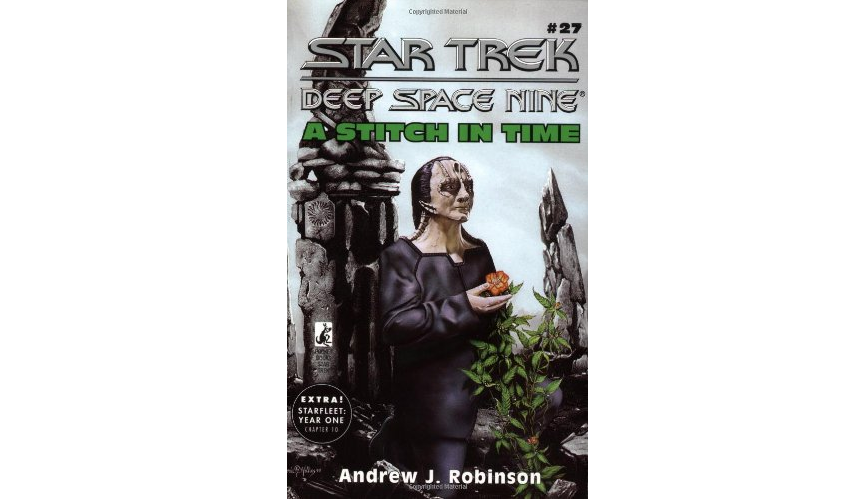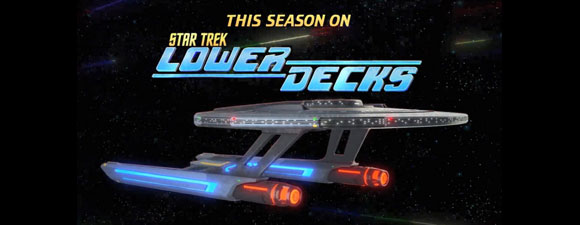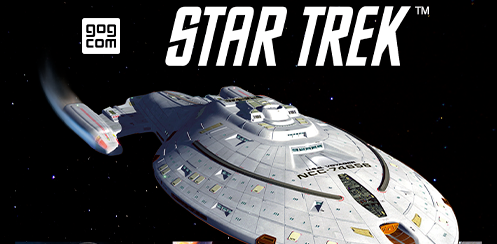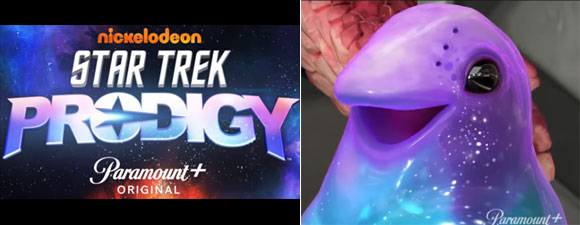Writing For Star Trek Part VIII: How To Pitch (Part One)
By Joseph D. Di LellaPosted at January 21, 2003 - 9:21 PM GMT
Before we begin our second to last tutorial session together, I'd just like to say that I hope your holiday season was a memorable one. What did Santa Claus leave you under the tree? A diamond ring, a car, or your very favorite item on the wish list: a DVD collection of your favorite Trek classics? My significant other, Elsbeth, bought me a discounted, Amazon.com copy of, Star Trek: The Deep Space Nine Companion, by Terry Erdsman and Paula Block (2000). Great gift.
And before I forget to ask -- did you enjoy, 'Star Trek: Nemesis'? A mere $36.6 million for the opening three weeks does not bode well for the movie franchise. Still, the overseas markets will push the overall gross well above the $60 million it took to produce the feature. Tell your friends to go; otherwise there may not be a Trek XI. And no, I am NOT a PR person from Enterprise or Paramount.
Now, on to the mission at hand. In total [from both parts of this article], we will hear from eight people with varying experiences pitching Trek. Theses 'day-in-the-life-of-a-pitch-artist' stories will allow you see various ways people create sharp, interesting stories for Star Trek. The stories in Part Two will also reveal to you that 'pitching success' is not merely about sales.
In Part One, you will hear from the most prolific freelancer in Trek history, Jimmy Diggs, and what makes that mind of his tick. Also, you will hear from Dr. Harry Kloor, and how a poorly received pitch can be transformed into a winning idea.
Shall we begin?
Personal & Family Experiences: Jimmy Diggs's Success Stories
Good Trek stories can come from many places in our exterior and interior worlds. Inspirational moments. A connection to the whelm of science, politics, technology, and culture. Sometimes, just a simple reflection on a personal experience can produce a well-received and successful Star Trek episode. My pal, Jimmy Diggs, has told me several stories over the years on our trips to Los Angeles, the convention circuit, or just chatting next to the computer terminal, trying to generate a beat sheet or other science fiction treatise. Two stories, in particular, standout as interesting approaches that successful people dream up, then pitch, to Star Trek.
Fact: Jimmy is a Vietnam veteran. Coincidentally, his military experience on the high seas not only helped him land his first job as a WGA intern with Star Trek, but also, directly, contributed to his first sale. As Jimmy puts it, Voyager's, "Elogium," storyline came to him one morning while reminiscing about his stint in the service . . . and that one unusual night under a starless sky.
According to Jimmy, his ship was about to pull into port from an especially long tour of duty. The captain, a stickler for neatness, wanted the battle cruiser to be in Bristol shape for an upcoming inspection. Without much help from a full moon or starry sky, the leader demanded hot spots light up the craft so his men could swab the decks and clean the upper regions of the hull. Deckhand Diggs, not one to dally, took to work that late night, a tough work shift that would later shape his memorable Trek career.
While scrubbing, scrapping and polishing his work station area, Jimmy couldn't help but notice a school of fish swim up next to the ship. But it wasn't a small group that begged for food from the galley remnants poured out to the sea. No, this was an entire fleet of aquatic creatures attracted to the lights. As the ship continued its slow, but steady passage to the city by the bay, the school became larger. By the time the aircraft carrier docked, the entire ship was surrounded by thousands of sea creatures.
This was an odd occurrence for the new naval cadets to witness; even stranger for a seasoned seaman like Jimmy to encounter. But the image struck him as only a Star Trek fan could understand. "The way the fish glistened in the water from the lights, it seemed, surreal. It felt like we were in outer space surrounded by millions of moving stars, and we were on a starship, our own, Enterprise," says Jimmy.
That special, unique memory stuck with him over the years. One early morning, when pitching his story to Jeri Taylor and Brannon Braga, Jimmy brought up the notion of space creatures wrecking havoc on Voyager. Similar to TNG's story, "The Loss," [where Counselor Diana Troi loses her empathic abilities when thousands of creatures tag along the USS Enterprise for a trip to their home in a quantum singularity], Jimmy pitched an idea that involves small space beings attracted to the ship (due to its' resonance signature). How does Captain Janeway and Company eventually kick off their unwelcome hobos, creatures that prevents the ship from going to warp? That's the central conundrum. Ms. Taylor, as Jimmy recalls of the meeting, brought up Kes's coming of age tale, and her need to mate as the 'B' storyline. "You know, I sold the story on a tag line," Jimmy says. "I said, when the crew discovers a way to rid themselves of the creatures and the beings eventually drift away from the vessel, Tuvok can say, "Captain, I believe that we've lost our sex appeal." That made Brannon laugh, and say the magic word, "Sold." Star Trek bought my very first story because of that one, funny, tag line."
Jimmy's next sale came a few years later, and one that involved a more intense, personal experience with his family.
"I didn't want to cancel my pitch session, because if you start doing that, you're in big trouble. You lose your status in the business. But, I had nothing. I was as dry as a bone. So I shunned a hurried drive to L.A. and took the train instead [from his home in San Diego]. I knew this would give me down time, and force me to focus on the job at hand. I just had to generate ideas for that pitch meeting latter that day," said Jimmy. And for him, the strategy worked beautifully.
On the two hour trip, his mind wandered back and forth from his pitch ideas to his troubled daughter. Jimmy's daughter's learning disability [dyslexia] held her back in school, and this bothered the father because he knew his child had tremendous potential. Diggs eventually blended his girl's problem into a story about Julian Bashir's [The doctor of Deep Space Nine] strange, almost absent character background.
"Hell, we didn't know anything about Bashir, except that he was second in his class for missing some stupid question about a pre-ganglia nerve on the final test. Then I thought, what if he's hiding something, and that's why we never really got to know the background of the man in the infirmary?" Jimmy goes on to say that he tried to imagine a not so horrible, but secretive thing Julian could be hiding. "I was thinking about what Starfleet would be steamed about if they only knew the truth about the real Bashir. What would they really hate? And then it came to me. Khan? Botany Bay?. The Eugenics Wars? What if Julian were genetically enhanced as a child? That's something he never would have told to or shown off to anyone; certainly not his close friends on the station, and especially, Sisko."
But Jimmy put a twist to Julian's past -- by placing Bashir's parent's as the culpable agents in the scheme. "This way, Julian doesn't take the fall for the actions." It's something, sometimes, Jimmy secretly wishes he could do for his daughter. "But would I make that decision, if those options were at my control? I think I would; but I don't know for sure. I wouldn't want my daughter coming back to me years later, asking, "Wasn't I good enough for you, Pop? Wasn't I smart enough?" Interesting problem. One, the writers of DS9, prompted by Jimmy's idea, developed for Mr. Siddig in, "Dr. Bashir, I Presume?," to enhance a character struggling for a special identity amongst the ranks of unusual people populating the space station.
At a cast party later that year, both Alexander Siddig and his wife at the time, Nana Visitor, approached the writer and thanked Jimmy for broadening Julian Bashir's character arc for the remaining two seasons of the series. "They were quite gracious about it," Jimmy said. "And I really felt appreciated. It made me feel . . . . special."
The Scientific Method in Trek: Harry 'Doc' Kloor
Dr. Harry Kloor, the first, simultaneous, double Ph.D. winner in US history (according to The New York Times, circa, May, 1994) is a scientist by nature. So you can expect a man of his background to pitch stories that involve science, technology and the human condition. Do you remember, "Scientific Method," where aliens experiment on a healthy, Voyager crew? How about, "Real Life," where the Holo Doc gets his own holographic family? What about, "Raven," a story that traces Annika Hansen/Seven of Nine's painful memories about her transformation from a young girl into a Borg? Yet, Harry's most famous episode was perhaps the best blend of science fiction and human drama ever presented on a Trek series.
According to Harry, it didn't start that way. Kloor's original pitch began with aliens pursuing Lt. Tom Paris's Delta Flyer. Tom eludes the bad guys, but the navigator nevertheless crash lands on the surface of a unknown planet. After Tom struggles out of the ship, he realizes his arm is almost, completely ripped off. A friendly alien from the technologically advanced race inhabiting the world, re-attaches the limb using Borg ingenuity. The staff writer taking the pitch shuttered at the time, saying, "Oh no, we can't do anything like that. The fans wouldn't want to see all that blood and gore."
Joe Menosky (interview presented on www.kristoffer.com, October 21, 1998), recalled Harry's original pitch as, "The Terminator Drone;" where Seven's nanoprobes infects the holo-emitter, creating an unstoppable, killer drone. But that central idea, too, fell by the wayside. Through about seven incarnations later, Harry and Bryan Fuller came up with a unique approach. What if the Doctor and Seven became parents of a rapidly matured, Borg? Harry's pitch eventually changed the 'killer' into a 'child,' the Borg learning life through his mother's and father's teachings.
Brannon Braga (quoted in the same article) loved the modified idea, but couldn't find a way to end the story. "When Seven gets into the role of mentor the same way Janeway has been her mentor, and gets to experience the loss [of her child]. . . that's what makes the episode very successful."
For 'Doc' Kloor, a one-line pitch is not all it took to make the sale. But a sale is a sale. Certainly not bad from a, "oh that's disgusting" to a "we'll pay you for that idea." Thus, "Drone" became one of the most respected Voyager stories ever produced on the back lot of Paramount.
Coming Soon: Please look for, "Part Two: How to Pitch for Star Trek" in my last installment in this series for TrekToday.
Discuss this articles at Trek BBS!![]() Add TrekToday RSS feed to your news reader or My Yahoo!
Add TrekToday RSS feed to your news reader or My Yahoo!
Also a Desperate Housewives fan? Then visit GetDesperate.com!
Joseph D. Di Lella is a freelance writer and panelist at the San Diego Comic Con. He can be reached via this page at AllExperts.com.



